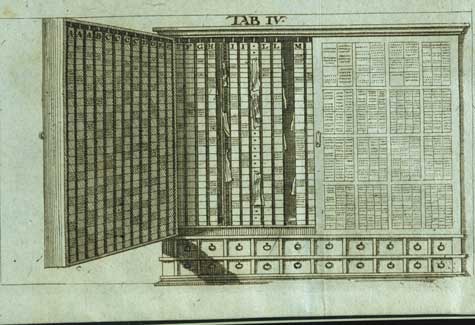Blair Ann
Too Much to Know: Managing Scholarly Information before the Modern Age
Yale University Press
416 pages, 6 x 10 inches
ISBN 978 0300112511
ISBN 978 0300165395
This book is about how the feeling of being overloaded with information, especially things to read, isn't a recent phenomenon. Similarly the tools for coping with overload, notably by managing information, have a long history.
In antiquity and the middle ages already scholars complained about the overabundance of books and the management tools in use included compilations of summaries and excerpts, organized under subject headings, and (starting in the 13th century) alphabetical indexing. When the spread of printing in the mid-15th century massively increased the number and availability of books, a much broader swath of the educated experienced overload and looked for remedies. The conditions were right for the commercial success of the reference book, which offered ready for use the best bits from all those books one didn’t have time to read.
Early printed reference books reached amazing proportions: a "standard" reference book like Domenico Nani Mirabelli's Polyanthea, printed in over 40 editions, reached 2.5 million words by the early 17th century. The largest reference book exceeded 10 million words, in eight massive folio volumes.
For comparison the last print version of the Encyclopedia Britannica, in 1985, amounted to 40 million words. Wikipedia, freed from the constraints of production on paper, has far surpassed these numbers; the English-language Wikipedia is now close to an estimated 2.5 billion words (according to the page linked here, as accessed on June 16, 2011).
I investigate how such huge books were made in the days of manuscript composition and the hand press. Compilers used their own copious notes taken by copying excerpts from their reading. But they also included material collected by others, in print or in manuscript. Then, to save labor, material for a large book was often cut and pasted (very literally, with scissors and glue) from notes, letters or even printed books. Once a first edition was published, it served as the basis for regularly expanded reeditions, to which compilers and their printers added new material and new finding devices of increasing sophistication, such as lists of contents with PowerPoint-style indentations and multiple kinds of alphabetical indexes.

Digitization makes a single copy stand for all copies of an edition, but not all the books in a print run were identical, and individual owners each used their copy in unique ways.
This book illustrates the long history of the basic moves of information management on which we still rely today, even with digital tools. I call them the 4S's: selecting, summarizing, sorting, and storing.
The criteria of utility have changed by which we select and summarize and sort, as have the media we use for storage. But we too still operate by choosing what to retain, by paraphrasing, quoting and labeling that material, so that we can find it again and combine it with other material in a process of human judgment and creativity. In examining the past of the working methods based on ink on paper that we are poised to abandon, we can reflect on what methods of working in the analog mode we want to be sure to transfer to the digital.
I started as an intellectual historian of early modern Europe (roughly 1450-1750) with a special interest in the history of science and how knowledge was diffused to non-specialists, e.g. to students and a broader educated readership (notably in encyclopedic works). Thanks to my teachers in graduate school and the scholars and librarians who helped me during my research abroad, I became interested in methods of book history.
In researching my dissertation, on an encyclopedia of natural philosophy by the famous political philosopher Jean Bodin, I conducted a survey of extant copies of that work and discovered how much one can learn from the surviving copies of a book—about the people who read the books, who left marks of ownership, annotations, personalized bindings, but also, thanks to the leads provided by these past readers, about what the text meant to them, which isn't always readily discernible to us today.
Since the late 1980s, when I first started doing research, digitization has opened up vast new possibilities for research in primary sources. But I am also convinced of the virtues of learning about books from viewing them first-hand whenever possible.
The physical copies hold many clues about how a book was used in its time and since—which cannot be fully conveyed by digitization. Digitization makes a single copy stand for all copies of an edition, but not all the books in a print run were identical, and individual owners each used their copy in unique ways. This is even more true of manuscripts, which are individually unique, and are comparatively rarely digitized for the early modern period.
Vincent Placcius, De arte excerpendi (1689), following page 153 in the book. Placcius notes that he was drawing on an earlier English manuscript from the 1640s, a copy of which is preserved at the British Library, and which has recently been identified as the work of Thomas Harrison, active in the circle of Samuel Hartlib.

My favorite chapter is the one on note-taking (chapter two). It is about how students and adults in the Renaissance were taught and encouraged to take notes.
Humanist pedagogues argued that note-taking served as a crucial aid to memory in two ways. First, it involved slowing down one's reading to write out the best parts and thus helped the reader attend to and retain the material better. Second, note-taking created a stock of written material which could be accumulated, sorted and indexed, and used throughout a lifetime as a storehouse from which to draw examples and quotations in speaking and composing new texts.
For the most committed note-takers one German professor, Vincent Placcius, published in 1689 instructions for building a large closet in which to store one's notes taken on slips of paper: when opened out the closet could store up 3,000 topical labels, each with a hook onto which to stick the slips that corresponded to that topic.
Placcius boasted that the closet could be especially useful for collaborative projects. For example students working together or the members of a learned society could pool their notes in one closet and then draw there from the collective stock of notes. At least two of these closets were built in the late 17th century, though we know of none that survive today.

In examining the past of the working methods based on ink on paper that we are poised to abandon, we can reflect on what methods of working in the analog mode we want to be sure to transfer to the digital.
Examining the working methods of scholars in the 16th and 17th centuries, as they faced an overabundance of books on a hitherto unprecedented scale, can help us see ourselves in a long history of managing information.
We still rely on techniques devised in the middle ages and the early modern period even as we develop new digital tools as well.
Some techniques with a long history (like alphabetization) may become obsolete as others take their place. And yet, through all the changes underway and still to come, I hope that we will continue to cultivate the qualities of mind that have always been at the root of intellectual reflection: human attention and memory and well-honed judgment.




We don't put paywalls. We don't distract you with ads. We don't sell your data.
Please help to keep this running!